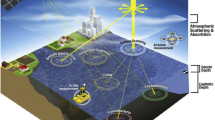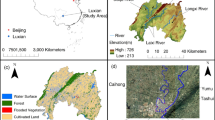Abstract
Water is called the “source of life”; it is the foundation of our human existence, and it is also an essential resource in the development of the country. Water pollution mainly includes two aspects. The first is that the water quality is polluted to a certain extent. Although our country has successively introduced many policies and measures to improve the water environment and reduce water pollution in recent years, people’s treatment of the water environment and the degree of attention is still not in place. The other is due to the extensive use of various pesticides and chemical fertilizers in the process of land planting and plant planting, resulting in a decrease in the water storage and drainage capacity of the soil. The quality of water resources has a certain degree of influence on the utilization efficiency of water resources. The full use of water resources refers to the use of water resources as raw materials or production costs into the production and operation process. While promoting urban development, the overall coordinated development of cities in adjacent or similar areas, especially cities with similar or the same water area, should be carried out, so that the development of each city and the development of the water area can coexist harmoniously. The theory of green development lies in the water. The definition in the efficient use of resources is to use the smallest possible investment in water resources in exchange for maximum benefits. This article organically combines the allocation of water resources with the protection and pollution control of the ecological and natural environment, so as to study the utilization of water resources in cities, and provide corresponding theoretical support for the improvement of the ecological environment of water resources and the increasing cleanliness.

















Similar content being viewed by others
Change history
13 December 2021
This article has been retracted. Please see the Retraction Notice for more detail: https://doi.org/10.1007/s12517-021-09258-7
28 September 2021
An Editorial Expression of Concern to this paper has been published: https://doi.org/10.1007/s12517-021-08471-8
References
Adamala S, Raghuwanshi N, Mishra A (2014) Development of surface irrigation systems design and evaluation software (SIDES). Comput Electron Agric 100:100–109
Chari MM, Davari K, Ghahraman B, ziaiei AN (2019) General equation for advance and recession of water in border irrigation. Irrig Drain 68:476–487
Chari MM, Poozan MT, Afrasiab P (2020) Modeling soil water infiltration variability using scaling. Biosyst Eng 196:56–66
Clemmens A, Bautista E (2009) Toward physically based estimation of surface irrigation infiltration. J Irrig Drain Eng 135(5):588–596
Duan R, Fedler CB, Borrelli J (2011) Field evaluation of infiltration models in lawn soils. Irrig Sci 29:379–389
Ebrahimian H, Liaghat A, Ghanbarian-Alavijeh B, Abbasi F (2010) Evaluation of various quick methods for estimating furrow and border infiltration parameters. Irrig Sci 28(6):479–488
Elliott RL, Walker WR (1982) Field evaluation of furrow infiltration and advance functions. Transaction of The ASAE 25(2):396–400
Ghorbani-Dashtaki S, Homaee M, Mahdian MH, Kouchakzadeh M (2009) Site-dependence performance of infiltration models. Water Resour Manag 23(13):2777–2790
Gillies MH (2008) Managing the effect of infiltration variability on the performance of surface irrigation. PHD dissertation. University of Queensland
Gillies MH, Smith RJ (2005) Infiltration parameters from surface irrigation advance and run-off data. Irrig Sci 24(1):25–35
Green WH, Ampt GA (1911) Studies on soil physics, 1. The flow of air and water through soils. J Agric Sci 4(1):1–24
Holtan HN (1961) A concept of infiltration estimates in watershed engineering. In: ARS41–51. Department of Agricultural Service, WashingtonDC, U.S.
Holzapfel EA, Jara J, Zuniga C, Marino MA, Paredes J, Billib M (2004) Infiltration parameters for furrow irrigation. Agric Water Manag 68:19–32
Horton RE (1941) An approach toward a physical interpretation of infiltration-capacity. Soil Sci Soc Am J 5(C):399–417
Isbell RF (1996) The Australian soil classification. CSIRO Publishing, Collingwood, p 143
James LG (1988) Principles of farm irrigation system design. John Wiley and Sons, New York, p 543
Kay M (1990) Recent developments for improving water management in surface irrigation and overhead irrigation. Agric Water Manag 17:7–23
Khatri KL, Smith RJ (2005) Evaluation of methods for determining infiltration parameters from irrigation advance data. Irrig Drain 54:467–482
Khatri KL, Smith RJ (2006) Real-time prediction of soil infiltration characteristics for the management of furrow irrigation. Irrig Sci 25(1):33–43
Kiefer F Jr (1965) Average depth of absorbed water in surface irrigation. Special Publication, \Logan
Kostiakov AN (1932) On the dynamics of the coefficient of water percolation in soils and the necessity of studying it from the dynamic point of view for the purposes of amelioration. Transaction of the Sixth Congress of International Society of Soil Science. Russian Part A, 17-21
Lewis MR, Milne WE (1938) Analysis of border irrigation. Agric Eng 19(6):267–272
Funding
The study was supported by “the Industry-University-Research Project of the Chinese Ministry of Education (Grant No. 201902242045)” and “Innovation Project of Hubei Provincial Department of Education, China (Grant No. S201910488084).”
Author information
Authors and Affiliations
Corresponding author
Ethics declarations
Conflict of interest
The authors declare that they have no competing interests.
Additional information
Responsible Editor: Sheldon Williamson
This article is part of the Topical Collection on Environment and Low Carbon Transportation
This article has been retracted. Please see the retraction notice for more detail: https://doi.org/10.1007/s12517-021-09258-7
About this article
Cite this article
Li, J., Wang, Z. RETRACTED ARTICLE: Sensor image-based non-point source pollution in river basins and improvement of water conservancy and environmental resource utilization efficiency. Arab J Geosci 14, 1513 (2021). https://doi.org/10.1007/s12517-021-07714-y
Received:
Accepted:
Published:
DOI: https://doi.org/10.1007/s12517-021-07714-y




